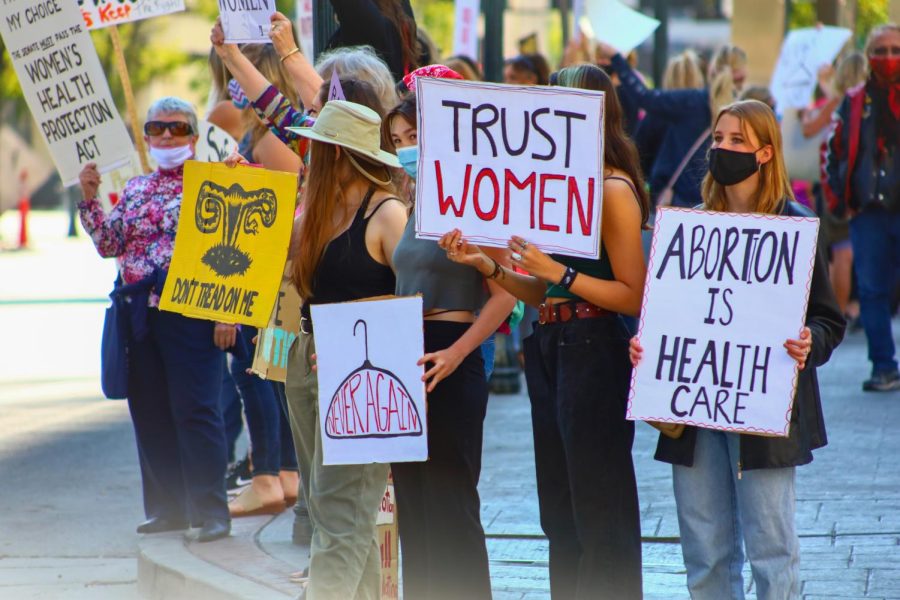Roe v. Wade Op Ed
“Pro-choice women protest for abortion rights in Reno, Nevada.”
March 3, 2023
In a 6-3 ruling on June 24, 2022, the United States Supreme Court overturned Roe v. Wade criminalizing abortion and tearing down nearly 50 years of reproductive rights. The severity of the ruling is not difficult to see; banning abortion denies previously-upheld rights and female bodily autonomy, which will inevitably increase death rates for women (especially those of color and those living below the poverty line). The ruling also fails to protect victims of rape and incest. Abortion must remain legal in all 50 states.
Society’s desire to control women is not new. Laws regarding women’s reproductive rights date back to the 17th century when in 1625 the United States adopted a British statute asserting that women who gave birth to a stillborn baby could be culpable of infanticide if they had not taken the proper steps to prepare for the pregnancy.
Horatio Storer, a member of the American Medical Association (AMA) called for the criminalization of abortion in the late 1850s because he felt it was a woman’s biological responsibility to be a mother. Further, before the establishment of the AMA, women held the majority of the knowledge regarding pregnancy and abortions which created unwanted competition for male physicians and members of the AMA feared women would become obstetricians if abortion remained legal.
By 1910, congress banned abortion nationwide. However, abortion was not uncommon during the ban. Women with unwanted pregnancies turned to dangerous and fatal methods of self-induced termination, such as herbs, drugs, and sharp objects. Coat hanger abortions, a method of termination used to induce abortion by inserting a metal hanger into the cervix and perforating the uterus, rose in popularity during abortion’s period of illegality. Coat-hanger abortions are dangerous and sometimes fatal, as the risk of lacerating an artery and bleeding to death is high.
The American College of Obstetricians and Gynecologists (ACOG) states that legal abortion is “extremely safe” and that the “risk of death associated with childbirth is approximately 14 times higher than that with abortion.” Additionally, the ACOG presents historical data that shows that rates of unsafe abortion generally increase in places where abortion is illegal or highly restricted. A 2021 study by Amanda Jean Stevenson compared the lifetime risk of pregnancy-related death (PRD) of white women and black women in 2017 with the estimated increased risk following a US ban on abortion. Stevenson found that all pregnancy-related deaths increased an estimated 21% in the years following 2017. Non-Hispanic Black people experienced a 33% increase in PRD. Further, before the passage of Roe, the ACOG states that approximately 800,000 US women resorted to illegal abortion practices, many of which ended in health complications and death.
Currently, twelve states prohibit abortion in the US. The ten states that will not make exceptions for rape or incest are: Alabama, Arkansas, Kentucky, Louisiana, Missouri, Oklahoma, South Dakota, Tennessee, Texas, and Wisconsin. Women and girls of reproductive age living in the above states will be unable to receive abortion healthcare, regardless of if they fell victim to rape and further rape or coercion by a family member. A 2018 Centers for Disease Control and Prevention study claimed, “Almost 3 million women in the US experienced Rape Related Pregnancy (RRP) during their lifetime.” Victims of rape-related pregnancy will likely take desperate and dangerous, if necessary, measures to terminate rape-related pregnancies.
The reasons for banning abortion lack discernment and empathy, and are rooted in misogyny and exist based upon a twisted marriage between politicians and religious zealots. Until the government can enact laws guaranteeing the safety of women from attackers, abusers, and traffickers, the need for a safe and legal method to terminate a pregnancy is a natural right. Until the government can regulate its broken financial system, the need for a safe and legal method to terminate a pregnancy is a choice only a mother can make. Until the government can force the father of a child to bear the responsibilities of a functional parent, the need for safe and legal abortions is the only choice for women.
































